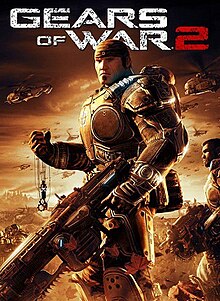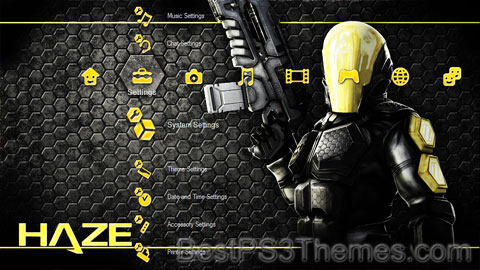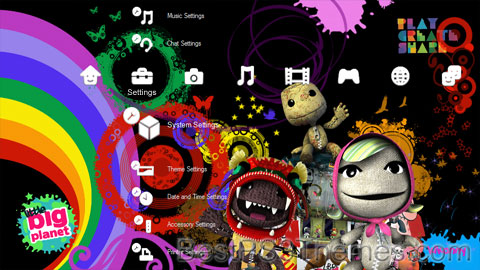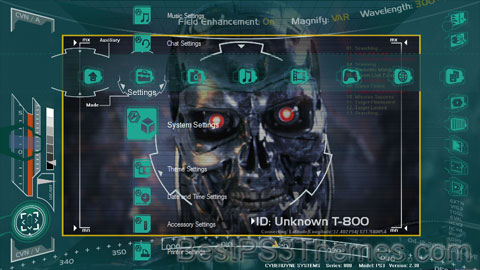Alicia Keys theme by Orlan
Download: AliciaKeys.p3t
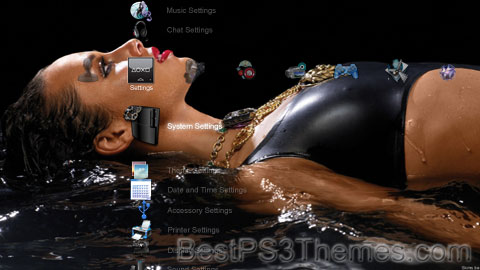
(6 backgrounds)
Alicia Keys | |
|---|---|
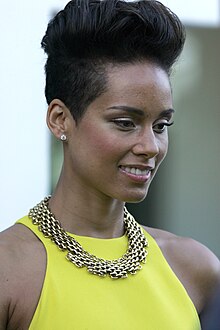 Keys in 2013 | |
| Born | Alicia Augello Cook January 25, 1981 New York City, U.S. |
| Other names | Lellow |
| Occupations |
|
| Years active | 1985–present |
| Organization | Keep a Child Alive |
| Works | |
| Spouse | |
| Children | 2 |
| Awards | Full list |
| Musical career | |
| Genres | |
| Instrument(s) |
|
| Labels | |
| Website | aliciakeys |
| Signature | |
 | |
Alicia Augello Cook (born January 25, 1981),[3][4][5][6][7] known professionally as Alicia Keys, is an American singer and songwriter. A classically trained pianist, Keys began composing songs when she was the age of 12 and was signed by Columbia Records at the age of 15. After disputes with the label, she signed with J Records to release her debut studio album, Songs in A Minor (2001). Met with critical acclaim and commercial success, the album sold over 12 million copies worldwide and won five awards at the 44th Annual Grammy Awards. It contained the Billboard Hot 100-number one single "Fallin'." Her second album, The Diary of Alicia Keys (2003) was met with continued success, selling eight million units worldwide and spawning the singles "You Don't Know My Name", "If I Ain't Got You", and "Diary" (featuring Tony! Toni! Toné!).[8] Its release earned an additional four Grammy Awards.[9]
Her 2004 duet with Usher, "My Boo", became her second number-one single. Alicia's first live album, Unplugged (2005), spawned the single "Unbreakable" and made her the first female artist to have an MTV Unplugged project debut atop the Billboard 200. Her third album, As I Am (2007), sold seven million units worldwide and yielded her third Billboard Hot 100-number one single. "No One." In 2007, Keys made her film debut in the action-thriller Smokin' Aces, and performed the theme song to the James Bond film Quantum of Solace with her single "Another Way to Die" (with Jack White) the following year.[10] Her fourth album, The Element of Freedom (2009), peaked the UK Albums Chart, sold four million copies worldwide, and was supported by the singles "Doesn't Mean Anything", "Try Sleeping with a Broken Heart", and "Un-Thinkable (I'm Ready)." That same year, her 2009 single "Empire State of Mind" (with Jay-Z) became her fourth number-one in the United States. Her fifth album, Girl on Fire (2012), became her fourth non-consecutive album to peak the Billboard 200 and was supported by its lead single of the same name; her sixth album, Here (2016), peaked at number two on the chart. Her seventh and eighth studio albums, Alicia (2020) and Keys (2021), spawned the singles "Show Me Love" (featuring Miguel), "Underdog", "Lala" and "Best of Me". Her first independent release, Santa Baby (2022), was a holiday album. In 2023, she wrote, composed and co-produced her first Broadway musical, Hell's Kitchen.
Keys has sold over 90 million records worldwide, making her one of the world's best-selling music artists. She was named by Billboard as the Top Artist of the 2000s in the R&B/Hip-Hop category,[11] and placed tenth on their list of Top 50 R&B/Hip-Hop Artists of the Past 25 Years. She has received numerous accolades in her career, including 16 Grammy Awards, 17 NAACP Image Awards, 12 ASCAP Awards, and an award from the Songwriters Hall of Fame and National Music Publishers Association. VH1 included her on their 100 Greatest Artists of All Time and 100 Greatest Women in Music lists, while Time has named her in their 100 list of most influential people in 2005 and 2017. Keys is also acclaimed for her humanitarian work, philanthropy, and activism. She co-founded the nonprofit HIV/AIDS-fighting organization Keep a Child Alive in 2003, for which she serves as Global Ambassador.
Early life, family and education[edit]
Alicia Augello Cook was born on January 25, 1981,[6][7] in the Hell's Kitchen neighborhood of Manhattan, New York City.[12][13] She is the only child of Teresa Augello, who was a paralegal and part-time actress, and one of three children of Craig Cook, who was a flight attendant.[14][15] Keys's father is African American and her mother is of Italian and "Irish or Scottish" descent; her mother's paternal grandparents were immigrants from Sciacca, Sicily;[16][17] and Lamezia Terme, in Calabria.[18] Named after her Puerto Rican godmother,[19] Keys has said that she was comfortable with her multiracial heritage because she felt she was able to "relate to different cultures".[12][20] Keys's father left when she was two years old. She was subsequently raised by her mother during her formative years at Manhattan Plaza[21] in Hell's Kitchen.[22] Keys has stated that her parents never had a relationship, and her father was not in her life.[23] Although she did not like to speak about her father in order to not feed stereotypes, Keys remarked in 2001: "I'm not in contact with him. That's fine. When I was younger, I minded about that. [It] made me angry. But it helped show me what a strong woman my mother was, and made me want to be strong like her. Probably, it was better for me this way."[12] Keys and her mother lived in a one-bedroom apartment.[24] Her mother often worked three jobs to provide for Keys, who "learned how to survive" from her mother's example of tenacity and self-reliance.[25]
I grew up in the middle of everything. I walked the streets alone, I rode the trains alone, I came home at three in the morning alone, that was what I did ... The city had a huge influence on me because it's such a diverse place. As hard as [growing up in it was], I always felt very blessed about being able to recognize different cultures and styles, people and places. I feel like the concrete alone just gave me a certain drive. I really saw everything: every negative I could possibly see from the time I could walk until now; and also every positive, every bright future, every dream that I could possibly see. So growing up around this big dichotomy definitely influenced my music.
From a young age, Keys struggled with self-esteem issues, hiding little by little when her differences made her vulnerable to judgment, and later uninvited sexual attention.[27][28][29] Living in the rough neighborhood of Hell's Kitchen,[22][23] she was, from an early age, regularly exposed to street violence, drugs, prostitution, and subjected to sexual propositions in the sex trade- and crime-riddled area.[29][30][31] "I saw a variety of people growing up, and lifestyles, lows and highs. I think it makes you realize right away what you want and what you don't want," Keys said.[32] Keys recalled feeling fearful early on of the "animal instinct" she witnessed, and eventually feeling "high" due to recurrent harassment.[27][33] Her experiences in the streets had led her to carry a homemade knife for protection.[34][35] She became very wary,[35][36] emotionally guarded, and she began wearing gender-neutral clothing and what would become her trademark cornrows.[39] Keys explained that she is grateful for growing up where she did as it prepared her for the parallels in the music industry, particularly as she was a teenager starting out; she could maintain a particular focus and not derail herself.[29][40] She credits her "tough" mother for anchoring her on a right path as opposed to many people she knew who ended up on the wrong path and in jail. Keys attributed her unusual maturity as a young girl to her mother, who depended on her to be responsible while she worked to provide for them and gave Keys as many opportunities as possible.[35][36]
Keys loved music and singing from early childhood. She recalled her mother playing jazz records of artists such as Thelonious Monk, Billie Holiday, Ella Fitzgerald, and Louis Armstrong on Sunday mornings—early musical moments Keys considers influential in kindling her interest in and emotional connection to music.[12][25] In preschool, Keys sang in her school's production of the musical Cats and was cast as Dorothy Gale in a production of The Wizard of Oz.[41] Keys discovered that she had a passion for the piano by age six, as she loved the sound and feel of the instrument and desired to play and learn it.[26][42] When Keys was ten,[43] a neighborhood friend who was moving home gave her family an old upright piano. This proved pivotal for Keys's musical development, which allowed her to practice, to play, and to benefit fully from music lessons at an early age.[23] Keys began receiving classical piano training by age seven,[44] practicing six hours a day,[42] learning the Suzuki method and playing composers such as Beethoven, Mozart, Chopin, and Satie.[23][45] She was particularly drawn to "blue, dark, shadowy" and melancholic compositions, as well as the passionate romanticism of "blue composers" like Chopin.[46] Inspired by the film Philadelphia, Keys wrote her first song about her departed grandfather on her piano by age 12. The scene in the film in which Tom Hanks's character listens to opera on a record player notably affected Keys, who "never showed emotion very well".[26] After seeing the film, Keys, "for the first time, could express how [she] felt through the music."[23][42]
Classical piano totally helped me to be a better songwriter and a better musician ... I knew the fundamentals of music. And I understood how to put things together and pull it together and change it. The dedication that it took to study classical music is a big reason why I have anything in this life I think. ... [It] was a big influence on me. It opened a lot of doors because it separated me from the rest. [...] And it did help me structure my songs.
—Keys[26]
Keys's mother had encouraged her to participate in different extracurricular activities, including music, dance, theater, and gymnastics, so she could "find her muse".[41][47] Her extracurricular activities gave her focus and drive, and helped keep her out of trouble.[34][42][45] Keys remained so occupied with her various pursuits that she experienced her first burnout before adolescence. Before her 13th birthday, she expressed to her mother that she was too overwhelmed and wanted to disengage, at which point her mother took some time off with her and encouraged her to keep focusing on piano.[41] Keys would continue studying classical music until the age of 18.[42] Keys regards her education in classical piano and dedication to classical music as vital for her stability in her youth and her development as a musician and songwriter.[12][26] Keys later said of her classical background:
That type of studying, that type of discipline ... after a while, I realized what it provided me – focus, the ability to pay attention for a long enough period of time to make progress; the work ethic; the actual knowledge of music, that then unlocked the ability to write my own music, put my own chords and things I heard in my own head to different lyrics that I maybe felt, and I never, ever had to wait for anybody to write something for me.[48]
Keys enrolled in the Professional Performing Arts School at the age of 12, where she took music, dance, and theater classes and majored in choir.[29] In her preteen years, Keys and her bass-playing friend formed their first group, though neither "knew too much about how pop songs worked".[23][45] Keys would continue singing, writing songs, and performing in musical groups throughout junior high and high school.[25][41][44] She became an accomplished pianist; according to some sources, after her classical-music teacher had nothing left to teach her, she began studying jazz at age 14[47][49] (this claim, however, was challenged by Keys's music teacher herself).[50] Living in the "musical melting pot" city, Keys had already been discovering other genres of music, including soul music, hip hop, R&B, and taken affinity to artists like Marvin Gaye and Curtis Mayfield. Keen on dissecting music, Keys continued developing her songwriting and finding her own 'flow and style" through her exploration of the intricacies in different music.[26][45][51]
Keys spent more time in Harlem during her teenage years. She connected with the cultural and racial diversity in the neighborhood, where she expanded upon her musical exploration, and her character was also solidified. "Harlem raised me in a lot of ways," Keys remarked. "[It] taught me how to think fast, how to play the game ... taught me leadership, how to get out of bad situations when you need to, how to hold my own."[12][44] During this period, she met her good friend who would later become her long-term collaborator and boyfriend Kerry Brothers Jr., also famously known as Krucial.[25][44]
Career[edit]
1985–1997[edit]
In 1985, at the age of four, Keys appeared on The Cosby Show as Maria, one of Rudy's slumber-party friends.[52]
In 1994, manager Jeff Robinson met 13-year-old Keys, who participated in his brother's youth organization called Teens in Motion.[41][53] Robinson's brother had been giving Keys vocal lessons in Harlem.[42] His brother had talked to him about Keys and advised him to go see her, but Robinson shrugged it off as he had "heard that story 1,000 times". At the time, Keys was part of a three-member band that had formed in the Bronx and was performing in Harlem.[41][49] Robinson eventually agreed to his brother's request, and went to see Keys perform with her group at the Police Athletic League center in Harlem. He was soon taken by Keys, her soulful singing, playing contemporary and classical music and performing her own songs.[41][44] Robinson was excited by audiences' reactions to her. Impressed by her talents, charisma, image, and maturity, Robinson considered her to be the "total package", and took her under his wing.[47][49][53] By this time, Keys had already written two of the songs that she would later include on her debut album: "Butterflyz" and "The Life".[47][49]
Robinson wanted Keys to be informed and prepared for the music industry, so he took her everywhere with him, including all the meetings with attorneys and negotiations with record labels, while the teenager often became disgruntled with the process.[41] Robinson had urged Keys to pursue a solo career, as she remained reluctant, preferring the musical interactions of a group. She took Robinson's advice after her group disbanded, and contacted Robinson who in 1995 introduced her to A&R executive Peter Edge.
Robinson and Edge helped Keys assemble some demos of songs she had written and set up a showcases for label executives.[25][41][44] Keys performed on the piano for executives of various labels, and a bidding war ensued.[23][44] Edge was keen to sign Keys himself but was unable to do so at that time due to being on the verge of leaving his present record company, Warner Bros. Records, to work at Clive Davis' Arista Records.[23][41][54] During this period, Columbia Records had approached Keys for a record deal, offering her a $26,000 white baby grand piano; after negotiations with her and her manager, she signed to the label, at age 15. Keys was also finishing high school, and her academic success had provided her opportunity for scholarship and early admission to university.[23][41][54] That year, Keys accepted a scholarship to study at Columbia University in Manhattan.[25] She graduated from high school early as valedictorian, at the age of 16, and began attending Columbia University at that age while working on her music.[23][47] Keys attempted to manage a difficult schedule between university and working in the studio into the morning, compounding stress and a distant relationship with her mother. She often stayed away from home, and wrote some of the most "depressing" poems of her life during this period. Keys decided to drop out of college after a month to pursue music full-time.[25][38][47]
Columbia Records had recruited a team of songwriters, producers and stylists to work on Keys and her music. They wanted Keys to submit to their creative and image decisions.[25] Keys said they were not receptive to her contributions and being a musician and music creator.[47][48] While Keys worked on her songs, Columbia executives attempted to change her material; they wanted her to sing and have others create the music, forcing big-name producers on her who demanded she also write with people with whom she was not comfortable.[12][42] She would go into sessions already prepared with music she had composed, but the label would dismiss her work in favor of their vision.[48] "It was a constant battle, it was a lot of -isms", Keys recalled. "There was the sexism, but it was more the ageism – you're too young, how could you possibly know what you want to do? – and oh God, that just irked me to death, I hated that."[25] "The music coming out was very disappointing", she recalled. "You have this desire to have something good, and you have thoughts and ideas, but when you finish the music it's shit, and it keeps on going like that."[44] Keys would be in "perpetual music industry purgatory" under Columbia, while they ultimately "relegated [her] to the shelf".[49] She had performed "Little Drummer Girl" for So So Def's Christmas compilation in 1996,[49] and later co-wrote the song "Dah Dee Dah (Sexy Thing)" for the Men in Black (1997) film soundtrack, the only released recording Keys made with Columbia.[38][42]
Keys "hated" the experience of writing with the people Columbia brought in. "I remember driving to the studio one day with dread in my chest," she recalled.[23] Keys said the producers would also sexually proposition her.[12][29][47] "It's all over the place. And it's crazy. And it's very difficult to understand and handle," she said.[47] Keys had already built a "protect yourself" mentality from growing up in Hell's Kitchen, which served her as a young teen then in the industry having to rebuff the advances of producers and being around people who "just wanted to use [her]".[29][40] Keys felt like she could not show weakness.[29] Executives at Columbia also wanted to manufacture her image, with her "hair blown out and flowing", short dresses, and asking her to lose weight; "they wanted me to be the same as everyone else," Keys felt.[23] "I had horrible experiences," she recalled. "They were so disrespectful ... I started figuring, 'Hey, nothing's worth all this.'"[12] As months passed, Keys had grown more frustrated and depressed with the situation, while the label requested the finished tracks.[23][44][47] Keys recalled, "it was around that time that I realized that I couldn't do it with other people. I had to do it more with myself, with the people that I felt comfortable with or by myself with my piano."[47] Keys decided to sit in with some producers and engineers to ask questions and watch them technically work on other artists' music.[44] "The only way it would sound like anything I would be remotely proud of is if I did it," Keys determined. "I already knew my way around the keyboard, so that was an advantage. And the rest was watching people work on other artists and watching how they layer things."[44]
Her partner Kerry "Krucial" Brothers suggested to Keys she buy her own equipment and record on her own.[47] Keys began working separately from the label, exploring more production and engineering on her own with her own equipment.[44] She had moved out of her mother's apartment and into a sixth-floor walk-up apartment in Harlem with Brothers, where she fit a recording studio into their bedroom and worked on her music.[47] Keys felt being on her own was "necessary" for her sanity. She was "going through a lot" with herself and with her mother, and she "needed the space"; "I needed to have my own thoughts, to do my own thing."[44] Keys and Brothers later moved to Queens and together they turned the basement into KrucialKeys Studios.[47] Keys would return to her mother's house periodically, particularly when she felt "lost or unbalanced or alone". "She would probably be working and I would sit at the piano," she reminisced.[47] During this time, she composed the song "Troubles", which started as "a conversation with God", working on it further in Harlem. Around this time the album "started coming together", and she composed and recorded most of the songs that would appear on her album.[36][44][47] "Finally, I knew how to structure my feelings into something that made sense, something that can translate to people", Keys. "That was a changing point. My confidence was up, way up."[44] The different experience reinvigorated Keys and her music.[47] While the album was nearly completed, Columbia's management changed and more creative differences emerged with the new executives. Keys brought her songs to the executives, who rejected her work, saying it "sounded like one long demo". They wanted Keys to sing over loops,[44] and told Keys they will bring in a "top" team and get her "a more radio-friendly sound". Keys would not allow it; "they already had set the monster loose", she recalled. "Once I started producing my own stuff there wasn't any going back."[47] Keys stated that Columbia had the "wrong vision" for her. "They didn't want me to be an individual, didn't really care," Keys concluded. "They just wanted to put me in a box."[12] Control over her creative process was "everything" to Keys.[48]
Keys had wanted to leave Columbia since they began "completely disrespecting [her] musical creativity".[23] Leaving Columbia was "a hell of a fight," she recalled. "Out of spite, they were threatening to keep everything I'd created even though they hated it. I thought I'd have to start over again just to get out, but I didn't care."[23] Keys said in 2001: "It's been one trial, one test of confidence and faith after the next." To Ke
Fergie
Fergie theme by Orlan
Download: Fergie.p3t
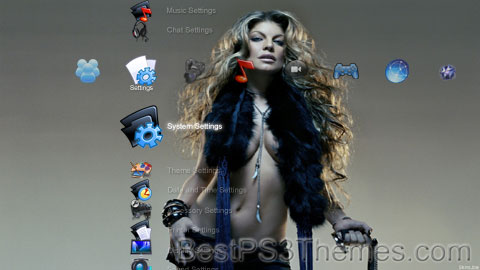
(6 backgrounds)
Fergie or Fergy or Fergee is a short form of the names Fergus, Ferguson, and Fergusson.
It may refer to:
People[edit]
- Fergie (DJ) (Robert Ferguson, born 1979), Irish DJ and former radio presenter
- Fergie (singer) (born Stacy Ann Ferguson, 1975), American singer-songwriter and actress
- Alex Ferguson (born 1941), Scottish former football manager
- Barry Ferguson (born 1978), Scottish football player
- Clive Fergie (1895–1960), the Australian rules footballer
- Darren Ferguson, Scottish football manager and former player, son of Alex Ferguson
- Dennis Frederiksen (1951–2014), American singer
- Fergie Aitken (1896–1989), Scottish footballer
- Fergie McCormick (1939–2018), New Zealand former rugby union footballer
- Fergie MacDonald (born c. 1940s), Scottish ceilidh dance band leader
- Fergie Olver, Canadian game show host and sportscaster
- Fergie Reid (1849–1924), Australian trade unionist and politician
- Fergie Semple (1922–2003), British Army brigadier and Director SAS
- Fergie Sutherland (1931–2012), Irish horse trainer
- Fergus Suter (1857–1916), Scottish footballer, arguably the first recognised professional footballer
- Ferguson Jenkins (born 1942), Canadian former Major League Baseball pitcher
- Fergy Brown (1923–2013), Canadian politician
- Fergy Malone (1844–1905), American baseball player
- Forest K. Ferguson (1919–1954), American college multi-sport athlete
- Henry G. Ferguson (1882–1966), USGS geologist
- Sarah, Duchess of York (née Sarah Ferguson, 1959), nicknamed "Fergie", the former wife of Prince Andrew, Duke of York
- Subhash Gupte (1929–2002), Indian cricketer
Other uses[edit]
- The Fergies, the Australian band
- Jack Ferguson Award (the Fergie), Ontario Hockey League ice hockey award
- Fergie Ferguson Award (the Fergie), University of Florida sports award
- Ferguson TE20, an agricultural tractor commonly known as the "Little Grey Fergie"
- Precision Tech Fergy, an ultralight aircraft
See also[edit]
SOCOM Confrontation HD
SOCOM Confrontation HD theme by SCHoTZ
Download: SOCOMConfrontationHD.p3t
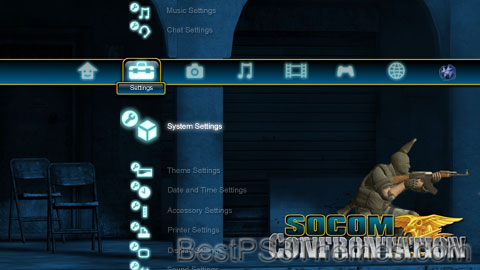
(8 backgrounds, HD only)
P3T Unpacker v0.12
Copyright (c) 2007. Anoop Menon
This program unpacks Playstation 3 Theme files (.p3t) so that you can touch-up an existing theme to your likings or use a certain wallpaper from it (as many themes have multiple). But remember, if you use content from another theme and release it, be sure to give credit!
Download for Windows: p3textractor.zip
Instructions:
Download p3textractor.zip from above. Extract the files to a folder with a program such as WinZip or WinRAR. Now there are multiple ways to extract the theme.
The first way is to simply open the p3t file with p3textractor.exe. If you don’t know how to do this, right click the p3t file and select Open With. Alternatively, open the p3t file and it will ask you to select a program to open with. Click Browse and find p3textractor.exe from where you previously extracted it to. It will open CMD and extract the theme to extracted.[filename]. After that, all you need to do for any future p3t files is open them and it will extract.
The second way is very simple. Just drag the p3t file to p3textractor.exe. It will open CMD and extract the theme to extracted.[filename].
For the third way, first put the p3t file you want to extract into the same folder as p3textractor.exe. Open CMD and browse to the folder with p3extractor.exe. Enter the following:
p3textractor filename.p3t [destination path]Replace filename with the name of the p3t file, and replace [destination path] with the name of the folder you want the files to be extracted to. A destination path is not required. By default it will extract to extracted.filename.
Jaune Tuning
Jaune Tuning theme by XICKAM (93)
Download: JauneTuning.p3t
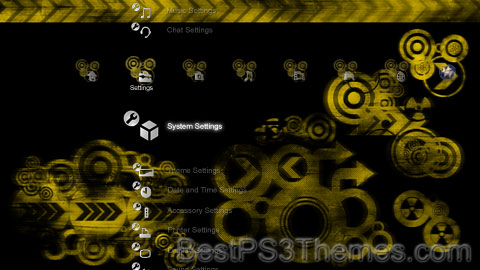
(1 background)
P3T Unpacker v0.12
Copyright (c) 2007. Anoop Menon
This program unpacks Playstation 3 Theme files (.p3t) so that you can touch-up an existing theme to your likings or use a certain wallpaper from it (as many themes have multiple). But remember, if you use content from another theme and release it, be sure to give credit!
Download for Windows: p3textractor.zip
Instructions:
Download p3textractor.zip from above. Extract the files to a folder with a program such as WinZip or WinRAR. Now there are multiple ways to extract the theme.
The first way is to simply open the p3t file with p3textractor.exe. If you don’t know how to do this, right click the p3t file and select Open With. Alternatively, open the p3t file and it will ask you to select a program to open with. Click Browse and find p3textractor.exe from where you previously extracted it to. It will open CMD and extract the theme to extracted.[filename]. After that, all you need to do for any future p3t files is open them and it will extract.
The second way is very simple. Just drag the p3t file to p3textractor.exe. It will open CMD and extract the theme to extracted.[filename].
For the third way, first put the p3t file you want to extract into the same folder as p3textractor.exe. Open CMD and browse to the folder with p3extractor.exe. Enter the following:
p3textractor filename.p3t [destination path]Replace filename with the name of the p3t file, and replace [destination path] with the name of the folder you want the files to be extracted to. A destination path is not required. By default it will extract to extracted.filename.
Scrabble
Scrabble theme by SCHoTZ
Download: Scrabble.p3t
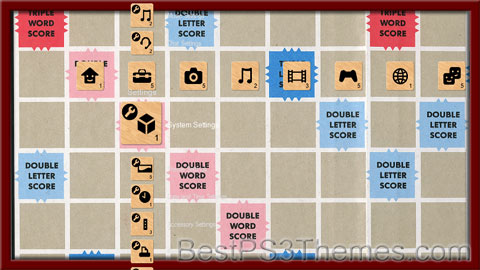
(1 background)
 A game of English-language Scrabble in progress | |
| Manufacturers | Hasbro (within U.S. and Canada) Mattel (outside U.S. and Canada) |
|---|---|
| Designers | Alfred Mosher Butts |
| Publishers | James Brunot |
| Publication | 1948 |
| Genres | Word game Board game |
| Players | 2–4 |
| Setup time | 2–4 minutes |
| Playing time | Tournament game: 50–60 minutes |
| Chance | Medium (letters drawn) |
| Skills | Vocabulary, spelling, anagramming, strategy, counting, bluffing, probability |
| Website | scrabble.hasbro.com |
Scrabble is a word game in which two to four players score points by placing tiles, each bearing a single letter, onto a game board divided into a 15×15 grid of squares. The tiles must form words that, in crossword fashion, read left to right in rows or downward in columns and are included in a standard dictionary or lexicon.
American architect Alfred Mosher Butts invented the game in 1938. Scrabble is produced in the United States and Canada by Hasbro, under the brands of both of its subsidiaries, Milton Bradley and Parker Brothers. Mattel owns the rights to manufacture Scrabble outside the U.S. and Canada. As of 2008, the game is sold in 121 countries and is available in more than 30 languages; approximately 150 million sets have been sold worldwide, and roughly one-third of American and half of British homes have a Scrabble set.[1][2][3][4] There are approximately 4,000 Scrabble clubs around the world.[4]
Game details[edit]
The game is played by two to four players on a square game board imprinted with a 15×15 grid of cells (individually known as "squares"), each of which accommodates a single letter tile. In official club and tournament games, play is between two players or, occasionally, between two teams, each of which collaborates on a single rack.[5]
The board is marked with "premium" squares, which multiply the number of points awarded: eight dark red "triple-word" squares, 17 pale red "double-word" squares, of which one, the center square (H8), is marked with a star or other symbol, 12 dark blue "triple-letter" squares, and 24 pale blue "double-letter" squares. In 2008, Hasbro changed the colors of the premium squares to orange for TW, red for DW, blue for DL, and green for TL, but the original premium square color scheme is still preferred for Scrabble boards used in tournaments.[6]
In an English-language set, the game contains 100 tiles, 98 of which are marked with a letter and a point value ranging from 1 to 10. The number of points for each lettered tile is based on the letter's frequency in standard English. Commonly used letters such as vowels are worth one point, while less common letters score higher, with Q and Z each worth 10 points. The game also has two blank tiles that are unmarked and carry no point value. The blank tiles can be used as substitutes for any letter; once laid on the board, however, the choice is fixed. Other language sets use different letter set distributions with different point values.

Tiles are usually made of wood or plastic and are 19 by 19 millimetres (0.75 in × 0.75 in) square and 4 mm (0.16 in) thick, making them slightly smaller than the squares on the board. Only the rosewood tiles of the deluxe edition vary in width up to 2 mm (0.08 in) for different letters. Travelling versions of the game often have smaller tiles (e.g. 13 mm × 13 mm (0.51 in × 0.51 in)); sometimes they are magnetic to keep them in place. The capital letter is printed in black at the centre of the tile face and the letter's point value is printed in a smaller font at the bottom right corner. Most modern replacement tile sets come at 18 mm × 20 mm (0.7 in × 0.8 in).
S is one of the most versatile tiles in English-language Scrabble because it can be appended to many words to pluralize them (or in the case of most verbs, convert them to the third person singular present tense, as in the word PLUMMETS); Alfred Butts included only four S tiles to avoid making the game "too easy". Q is considered the most troublesome letter, as almost all words with it also contain U; a similar problem occurs in other languages like French, Dutch, Italian, and German. J is also difficult to play due to its low frequency and a scarcity of words having it at the end.[7] C and V may be troublesome in the endgame, since no two-letter words with them exist, except for CH in the Collins Scrabble Words lexicon.
History[edit]
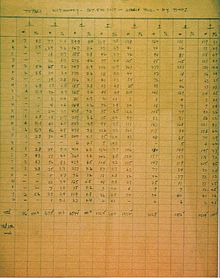
In 1938, the American architect Alfred Mosher Butts created the game as a variation on an earlier word game he invented, called Lexiko. The two games had the same set of letter tiles, whose distributions and point values Butts worked out by performing a frequency analysis of letters from various sources, including The New York Times. The new game, which he called Criss-Crosswords, added the 15×15 gameboard and the crossword-style gameplay. He manufactured a few sets himself but was not successful in selling the game to any major game manufacturers of the day.[9]: 98
In 1948, James Brunot,[10] a resident of Newtown, Connecticut, and one of the few owners of the original Criss-Crosswords game, bought the rights to manufacture the game in exchange for granting Butts a royalty on every unit sold. Although he left most of the game (including the distribution of letters) unchanged, Brunot slightly rearranged the "premium" squares of the board and simplified the rules; he also renamed the game Scrabble, a real word which means "to scratch frantically".[9]: 100 In 1949, Brunot and his family made sets in a converted former schoolhouse in Dodgingtown, Connecticut, a section of Newtown. They made 2,400 sets that year but lost money.[11] According to legend, Scrabble's big break came in 1952 when Jack Straus, president of Macy's, played the game on vacation. Upon returning from vacation, he was surprised to find that his store did not carry the game. He placed a large order, and within a year, "everyone had to have one".[9]: 101
In 1952, unable to meet demand himself, Brunot licensed the manufacturing rights to Long Island-based Selchow and Righter, one of the manufacturers who, like Parker Brothers and Milton Bradley Company, had previously rejected the game. "It's a nice little game. It will sell well in bookstores," Selchow and Righter president Harriet T. Righter remembered saying about Scrabble when she first saw it.[12] In its second year as a Selchow and Righter product, 1954, nearly four million sets were sold.[13][9]: 104 Selchow and Righter then bought the trademark to the game in 1972.[14]
Meanwhile, JW Spear acquired the rights to sell the game in Australia and the UK on January 19, 1955.[9] In 1986, Selchow and Righter was sold to Coleco, which soon afterward went bankrupt. Hasbro then purchased Coleco's assets in 1989, including Scrabble and Parcheesi.[14] Mattel then acquired JW Spear in 1994.[9] Since then, Hasbro has owned the rights to manufacture Scrabble in the U.S. and Canada, and Mattel has held the rights to manufacture the game in other parts of the world.[14]


In 1984, Scrabble was turned into a daytime game show on NBC. The Scrabble game show ran from July 1984 to March 1990,[15] with a second run from January to June 1993. The show was hosted by Chuck Woolery. Its tagline in promotional broadcasts was, "Every man dies; not every man truly Scrabbles."[16] In 2011, a new TV variation of Scrabble, called Scrabble Showdown, aired on The Hub cable channel, which is a joint venture of Discovery Communications, Inc. and Hasbro.
Scrabble was inducted into the National Toy Hall of Fame in 2004.[17]
Evolution of the rules[edit]
The "box rules" included in each copy of the North American edition have been edited four times: in 1953, 1976, 1989, and 1999.[18]
The major changes in 1953 were as follows.
- It was made clear that:
- words could be played through single letters already on the board,
- a player could play a word parallel and immediately adjacent to an existing word provided all crossing words formed were valid,
- the effect of two premium squares was to be compounded multiplicatively.
- The previously unspecified penalty for having one's play successfully challenged was stated: withdrawal of tiles and loss of turn.
The major changes in 1976 were as follows.
- It was made clear that the blank tile beats an A when drawing to see who goes first.
- A player could pass their turn, doing nothing.
- A loss-of-turn penalty was added for challenging an acceptable play.
- If final scores are tied, the player whose score was highest before adjusting for unplayed tiles is the winner;[19] in tournament play, a tie is counted as half a win for both players.[6]
The editorial changes made in 1989 did not affect gameplay.[18]
The major changes in 1999 were as follows.
- It was made clear that:
- a tile can be shifted or replaced until the play has been scored,
- a challenge applies to all the words made in the given play.
- Playing all seven tiles is officially called a "bingo" in North America and a "bonus" elsewhere.
- A change in the wording of the rules could have been interpreted as meaning that a player may form more than one word on one row on a single turn.
Rules[edit]
Before the game, a word list or dictionary is selected in order to adjudicate any challenges during the game. In tournament play, the word list is specified in advance, typically the NASPA Word List, the Official Scrabble Players Dictionary, or Collins Scrabble Words. All 100 tiles are placed into an opaque bag. To decide which player plays first, each player draws one tile from the bag. The player who picks the letter closest to "A" goes first, with blanks taking precedence over the letter A. Each player then draws seven tiles and places them on their rack, hidden from other players.

Gameplay[edit]
On every turn, the player at turn can perform one of the following options:
- Pass, forfeiting the turn and scoring zero.
- Exchange one or more tiles for an equal number from the bag, scoring zero. This can only be done if 7 or more tiles remain in the bag.
- Play at least one tile on the board, adding the value of all words formed to the player's cumulative score.
The first play of the game must consist of at least two tiles and cover the center square (H8). Any play thereafter must use at least one of the player's tiles to form a "main word" (containing all of the player's played tiles in a straight line) reading left-to-right or top-to-bottom. Diagonal plays are not allowed. At least one tile must be adjacent (horizontally or vertically) to a tile already on the board. After making a play, the player announces the score for that play (see Scoring for more details), and then, if the game is being played with a clock, starts their opponent's clock. If the opponent does not challenge the play, the player then draws tiles equal to the number of tiles played, or all tiles if there are not enough tiles in the bag to do so.
If a player has made a play and not yet drawn a tile, any other player may choose to challenge any or all words formed by the play. The word(s) are then searched in the agreed-upon word list or dictionary, and if one or more of them is found to be unacceptable, the play is removed from the board, and the player scores zero for that turn. If all challenged words are acceptable, the challenger loses their turn. In tournament play, a challenge may be to the entire play or any one or more words formed in the play, and players are not entitled to know which word(s) are invalid or the definitions of any challenged words. Penalties for unsuccessfully challenging an acceptable play vary in club and tournament play and are described in greater detail below.
End of game[edit]
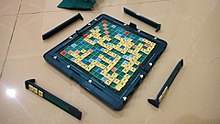
The game ends when either:
- One player has played every tile on their rack ("playing out") and no tiles remain in the bag (regardless of the tiles on the opponent's rack).
- At least six successive scoreless turns have occurred and either player decides to end the game. This typically occurs at the end of the game when none of the players can form a valid word with their tiles. (For several years, a game could not end with a cumulative score of 0–0, but that is no longer the case, and such games have since occurred a number of times in tournament play, the winner being the player with the lower total point value on their rack and thus a score less negative than the opponent's.[20])
- In tournament play, if either player uses more than 10 minutes of overtime.
When the game ends, each player's score is reduced by the sum of the values of their unplayed tiles. If a player plays out, the sum of all other players' unused tiles is added to that player's score. In tournament play, a player who goes out adds twice that sum, and the opponent's score is unchanged. The player with the highest final score wins the game.
Scoring[edit]
| Square | Original and Mattel version | Hasbro Version (2008–2014) |
|---|---|---|
| Double letter (DLS) | Light blue | Blue |
| Triple letter (TLS) | Dark blue | Green |
| Double word (DWS) | Pink | Red |
| Triple word (TWS) | Red | Orange |
The score for a play is determined as follows:
- The value of each tile is indicated with a point values (between 1 and 10, with blanks worth zero points), and the score of every new word formed is equal to the sum of the point values of the letters in that word. If a play covers any premium squares (such as DLS or TWS squares), the point value of the corresponding letter or word is multiplied by 2 or 3 respectively. The center star is also a DWS square.
- Premium squares only apply when newly placed tiles cover them. Any subsequent plays do not count these premium squares. A play that covers a DWS or TWS multiplies the value of the entire word(s) by 2 or 3, including tiles already on the board.
- If a newly placed word covers both letter and word premium squares, the letter premium(s) is/are calculated first, followed by the word premium(s).
- If a player makes a play where the main word covers two DWS squares, the value of that word is doubled, then redoubled (i.e. 4× the word value). Similarly, if the main word covers two TWS squares, the value of that word is tripled, then re-tripled (9× the word value). Such plays are often referred to as "double-doubles" and "triple-triples" respectively.
- If a player plays all seven of their tiles on their turn (known as a "bingo" in North America and as a "bonus" elsewhere), a 50-point bonus is added to the score of the play.
Scoreless turns can occur when a player passes, exchanges tiles, loses a challenge, or otherwise makes an illegal move. A scoreless turn can also occur if a play consists of only blank tiles, but this is extremely unlikely in actual play.
Scoring example[edit]
See the example board at right.

Suppose Player 1 plays QUITE 8D, with the Q on a DLS and the E on the center star. Because the center star is a DWS, the score for this play is points.
Player 2 extends the play to form the word MES(QUITE) 8A with the A on the TWS at 8A. The score for this play is points. The Q is not doubled, as the Q was not played on this turn.
Player 1 plays INFaNCY 9D with a blank A, forming five 2-letter words, QI, UN, IF, TA, and EN. Because several additional words were formed, each new word is scored separately. The score for this play, without the 50-point bonus, is
points. Because all 7 tiles were played on this turn, a 50-point bonus is added, and the score for this play is points.
Player 2 plays RECO(UN)TS E4 through the word UN. Because this word covers two DWS squares, the score for this word is quadrupled, and the score for the play is points. Player 1 is ahead 136-97.
Acceptable words[edit]
All words that appear in the agreed-upon dictionary or lexicon are acceptable words in Scrabble, as are all their inflected forms, as well as plurals. Words that contain apostrophes or are hyphenated or capitalized (such as proper nouns) are generally not allowed unless they also appear as acceptable entries; for example, words such as JACK and TEXAS, while typically considered proper nouns, have unrelated meanings and are therefore acceptable in major Scrabble lexicons. Acronyms and abbreviations, other than those that have acceptable entries (such as AWOL, RADAR, SCUBA, and WYSIWYG[21]) are not allowed. Variant spellings, slang or offensive terms, archaic or obsolete terms, and specialized jargon words are acceptable if they meet all other criteria for acceptability, but archaic spellings (e.g., NEEDE or MAKETH) are generally not acceptable words. Foreign words are not allowed in English-language Scrabble unless they have been incorporated into the English language, such as the words QI,[22] KILIM, and PATISSERIE.
Vulgar and offensive words are generally excluded from the Official Scrabble Players Dictionary but allowed in club and tournament play. The North American Scrabble Players Association removed slurs from its lexicon in 2020, after conducting a poll of its members.[23] Mattel removed 400 derogatory terms from its official word list in 2021, in response to the Black Lives Matter movement, with the company's head of games saying: "Can you imagine any other game where you can score points and win by using a racial epithet? It’s long overdue."[24] This does not exclude players from playing these words, as it is within the rules of the game to play unacceptable words (at the risk of losing a challenge).
There are two popular competition word lists for English-language Scrabble:
- NASPA Word List (NWL, also known as OTCWL, OWL, or TWL)
- Collins Scrabble Words (CSW, also called "Collins" or "SOWPODS")
The first predominates in the U.S., Canada, Israel and Thailand, and the second in English Scrabble in the rest of the world. There is also a large community of competitive Collins players in North America, with its own NASPA rating system.
NWL and OSPD[edit]
Today's NASPA Word List, published by NASPA Games, descends from the Official Tournament and Club Word List (a non-bowdlerized version of the Official Scrabble Players Dictionary) and its companion Long Words List for longer words. The current version of NWL is NWL2020, effective January 2021, and the Official Scrabble Players Dictionary, published by Merriam-Webster, is currently in its sixth edition of 2018. NWL includes all current OSPD words, plus several hundred offensive words and genericized trademarks such as KLEENEX; as of 2020, it no longer includes words judged to be personally applicable offensive slurs.
The NWL and OSPD are compiled using a number of major college-level dictionaries, principally those published by Merriam-Webster. If a word appears, at least historically, in any one of the dictionaries, it is included in the NWL and the OSPD. If the word has only an offensive meaning, it is included only in the NWL. The key difference between the OSPD and the NWL is that the OSPD is marketed for "home and school" use, without words which their source dictionaries judged offensive, rendering the Official Scrabble Players Dictionary less fit for official Scrabble play. The OSPD is available in bookstores, while the NWL is available only through NASPA.
Collins Scrabble Words[edit]
In all other English-speaking countries, the competition word list is Collins Scrabble Words 2019 edition, known as CSW19. (Versions of this lexicon before 2007 were known as SOWPODS.) The lexicon includes all allowed words 2 to 15 letters long. Historically, this list has contained all OTCWL words plus words sourced from Chambers and Collins English dictionaries, but recent editorial decisions have caused greater discrepancies between CSW and NWL. This book is used to adjudicate at the World Scrabble Championship and all other major international competitions outside North America.
Tournaments are also played using CSW in North America, particularly since Hasbro ceased to control tournament play in 2009. NASPA, the Word Game Players Organization, and Collins Coalition (CoCo) all sanction CSW tournaments, using separate Elo rating systems.[25]
Challenges[edit]
The penalty for a successfully challenged play is nearly universal: the offending player removes the tiles played and forfeits their turn. (In some online games, a
D-Generation X
D-Generation X theme by LoneStarTX
Download: D-GenerationX.p3t
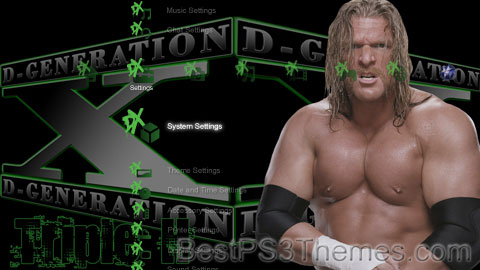
(3 backgrounds)
This article needs additional citations for verification. (September 2021) |
| D-Generation X | |
|---|---|
 D-Generation X logo in the 1990s | |
| Stable | |
| Leader(s) | Shawn Michaels Triple H |
| Members | X-Pac Road Dogg |
| Name(s) | D-Generation X DX Degeneration X DX Army |
| Former member(s) | Billy Gunn Rick Rude Chyna Mike Tyson Stephanie McMahon Tori Hornswoggle |
| Debut | August 11, 1997 |
| Years active | 1997–2000 2006–2010 2010–present (non-wrestling reunions) 2018[1] |
D-Generation X (DX) is an American professional wrestling stable, and later a tag team, that consisted of various members, most notably Shawn Michaels, Triple H, Chyna, X-Pac, and the New Age Outlaws.
The group originated in the World Wrestling Federation (WWF, now known as WWE) shortly before the "Attitude Era" in 1997 as a foil to another prominent faction, The Hart Foundation and became one of the main driving forces behind the WWF competing with World Championship Wrestling (WCW) in the Monday Night War. In addition to two other founding members, Chyna and Rick Rude, the group later expanded with new additions X-Pac, The New Age Outlaws (Road Dogg and Billy Gunn), and Tori until the group officially disbanded in August 2000. After a teased reunion in 2002, DX reformed in June 2006 as the duo of Triple H and Shawn Michaels for the remainder of the year[2] and again in August 2009 until March 2010, shortly before Michaels' retirement. This incarnation was voted the greatest WWE Tag Team Champions of all time in a 2013 WWE viewer poll.[3]
On October 8, 2018, it was announced that DX would face The Brothers of Destruction (The Undertaker and Kane) at the Crown Jewel pay-per view. At the event, Triple H and Michaels were victorious against Undertaker and Kane. On February 18, 2019, it was announced that the group would be inducted into the WWE Hall of Fame later that year, with Triple H, Michaels, Chyna, The New Age Outlaws, and X-Pac as the inducted members.
Concept[edit]
The group's gimmick was best known as a gang of rebels who broke the rules, acted and spoke as they pleased, and wrestled whomever they wanted no matter how provocative and insulting. Noted for their crude, profane humor and sophomoric pranks, the stable has been dubbed multiple times as the "most controversial group in WWF/E history". Michaels' autobiography suggests that it was WWF head writer Vince Russo who first conceived the moniker for the faction, while Bret Hart claims it originated from New York Post columnist Phil Mushnick, a frequent critic of the WWF.[4] Triple H also claims that Shane McMahon coined the name of D-Generation X when responding to Bret Hart's characterization of younger wrestlers as degenerates.[5]
DX was one of the three main contributing factors,[6][better source needed] along with Stone Cold Steve Austin and The Rock, to the onset of the WWF's Attitude Era. WWF/E Chairman Vince McMahon has repeatedly denied that DX was inspired or heavily influenced by World Championship Wrestling's (WCW) New World Order (nWo), though the core members of both on-screen factions included members of The Kliq; (Sean Waltman even served as a member of both groups; as did Michaels, briefly, during the nWo's short-lived revival in the WWF/E in 2002). On October 6, 1997, in one of the earliest DX promos, Michaels alluded to this off-screen connection. After Bret Hart claimed to have destroyed the Kliq and to have "run [Scott Hall and Kevin Nash] outta town" (referring to Hall and Nash leaving the WWF and signing with WCW), Michaels declared, "The Kliq owns this [professional wrestling] business", and said that the group had simply undergone "expansion" rather than "destruction".
History[edit]
Formation and early rivalries (1997–1998)[edit]

According to Triple H, WWF management wanted to keep The Kliq apart on-screen, so they were hesitant to pair he and Michaels together at first.[7] Despite this, the group began to form during the August 11, 1997 main event of Raw Is War. During Michaels' match with Mankind, Triple H (then wrestling under the ring name of Hunter Hearst Helmsley) and Chyna both interfered as Helmsley had been recently feuding with Mankind; towards the end of the match also saw Rick Rude return to the WWF revealing himself as Michaels' "insurance policy" and helped him win the match by attacking Mankind with a chair.[8][9] The following week on Raw, Michaels and Helmsley teamed up to take on Mankind and The Undertaker in the main event, only to lose the match by disqualification after Michaels used a chair on Undertaker.[8][10] Michaels would eventually face the Undertaker at Ground Zero: In Your House on September 7 with Helmsley, Chyna and Rude all interfering on Michaels' behalf to force the match to end in a no contest.[11] During this time, the group (Michaels and Helmsley in particular) were regularly shown on television practicing sophomoric/crude humor and rebelling against authority figures in the company, primarily Vince McMahon (then primarily presented as an on-screen commentator) and then-Commissioner Sgt. Slaughter, the latter of which DX made a recurring habit of humiliating by giving him the nickname "Sgt. Slobber".
D-Generation X's first major feud was against the Hart Foundation, which was led by Michaels' nemesis Bret Hart. At WWF One Night Only, the rest of DX helped Michaels defeat Foundation member British Bulldog for the WWF European Championship, officially making Michaels the WWF's first Grand Slam Champion.[12][13][14] On-screen, the name was taken from comments by Hart, who on several occasions, particularly including the October 6, 1997 episode of Raw Is War, had labeled Michaels "nothing more than a degenerate".[15] The following week, on October 13, 1997, Michaels made "D-Generation X" the group's official name,[16] mockingly citing Hart's insults as his inspiration and how Generation X (with both members being part of Generation X) is always stereotyped as apathetic and cynical.
Although DX and the members of the Hart Foundation continued to battle on-screen in one fashion or another through the end of 1997, the Bret Hart-Shawn Michaels feud ended abruptly at Survivor Series when Michaels won his third WWF Championship via the Montreal Screwjob, whereby Hart was lied to about the match's pre-determined outcome after Hart had signed with World Championship Wrestling (WCW) and refused to drop the WWF Championship to Michaels in Canada and instead agreed to drop the title one month later in Springfield, Massachusetts.[17][18][19] Rick Rude was also legitimately upset over the events of the screwjob, and subsequently left the WWF to return to WCW. On the November 24 episode of Raw Is War, DX invited Jim "The Anvil" Neidhart to join the group which he accepted prior to a match later that night between Vader and Michaels. Michaels, Chyna and Helmsley assaulted Neidhart at the end of the show after Michaels defeated Vader showing that Neidhart's invitation to the group was nothing more than a ruse.[20] The following week on the December 1 episode of Raw Is War, Helmsley defeated Neidhart.[21] After the match, DX assaulted Neidhart once again, before Michaels spray-painted "WCW" on Neidhart's back, and signifying him following Bret Hart and The British Bulldog to WCW.[21] Sgt. Slaughter and Ken Shamrock saved Neidhart, before Slaughter and Shamrock attacked DX at the end of the show.[21]
D-Generation X was used as the title for a WWF D-Generation X: In Your House pay-per-view telecast on December 7, 1997.[22] By this point, with Michaels holding both the WWF and WWF European Championships, and DX's victory in the feud with the Hart Foundation, their status as the lead stable in the company was solidified. Michaels headlined the event and was disqualified in a WWF Championship title defense against Ken Shamrock when Owen Hart interfered, having not been seen on WWF television since Survivor Series.[22] Earlier in the night, Helmsley (now primarily wrestling under the ring name of Triple H) defeated Sgt. Slaughter with the help of Chyna in a Boot Camp match.[22][23] On the December 22 episode of Raw is War however, Michaels and Triple H were forced by Slaughter to wrestle each other for the European Championship.[24] In a mock match, Michaels laid down in the middle of the ring while Triple H constantly ran the ropes.[24] Triple H would then pin Michaels and win the European Championship.[24][25]
Triple H lost the European Championship to Owen Hart in January 1998 only to regain it two months later.[26][27][28] Going into WrestleMania XIV that March, Shawn Michaels was the reigning WWF Champion and Triple H was the reigning WWF European Champion. Heavyweight boxer Mike Tyson was also involved as the "special enforcer" in the main event of the night featuring Michaels against Stone Cold Steve Austin. In the weeks leading up to the event, Tyson was revealed to have joined D-Generation X and looked as if he was going to help Michaels retain the championship.[29] However, at the end of the match, Tyson turned on DX and cost Michaels the match and the WWF Championship, allowing Austin to win the title.[30][31]
Michaels' departure and "DX Army" (1998–1999)[edit]
The night after WrestleMania, Triple H officially ejected Michaels from DX for "dropping the ball" over the Tyson incident and subsequently losing the WWF Championship.[32] In reality, Michaels had suffered a severe back injury during his Casket Match with The Undertaker at the Royal Rumble, and started what would become a four-year hiatus from wrestling to recuperate.[7] Triple H would assume full leadership of DX and recruited X-Pac, who had been recently fired from WCW, and the current WWF Tag Team Champions The New Age Outlaws ("Bad Ass" Billy Gunn and "The Road Dogg" Jesse James) into the stable. Triple H would dub this his new "DX Army".[32][7] While the intent was for the stable to remain heels, they quickly became popular with audiences and were eventually pushed as faces. During this time, they feuded with The Rock and his group the Nation of Domination and then later, Vince McMahon's Corporation.[7][33] The group remained united throughout 1998 and into early 1999.[vague][citation needed]
On episodes of Raw Is War in April and May[vague] DX "went to war" with WCW, with whom the WWF were in direct competition at the time, through a series of legitimate visits to WCW headquarters and live events. On April 27, 1998, Raw Is War and Nitro both took place in the Hampton Roads area of Virginia, a mere 19 miles apart. DX traveled from the WWF show in Hampton Coliseum, in Hampton to The Scope in Norfolk and shouted insults against WCW through a bullhorn, as well as accusing WCW of giving out free tickets to fill up arenas for television while sporting black armbands with the acronym "POWCW" (Prisoner of WCW), which referenced fellow Kliq members Scott Hall and Kevin Nash. They then tried to enter the arena via a loading dock in their army jeep before being stopped by someone closing the door.[34] They also attempted to forcibly secure meetings with Nitro's executive producer Eric Bischoff and WCW owner Ted Turner at WCW headquarters in Atlanta, Georgia. Another segment used computer graphics to make it appear as if Triple H had flown over the Roberts Municipal Stadium in Evansville, Indiana where WCW Nitro was taking place and wrote "WCW Sucks" and "DX Says Suck It" in the sky.[33]
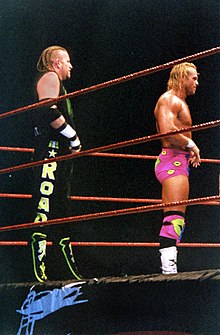
The group also feuded with the new Corporate Commissioner, former DX leader Shawn Michaels, who had turned heel and betrayed the group after costing X-Pac a WWF Championship match against The Rock.[35] The faction would continue to feud with Michaels and The Corporation throughout late 1998, with Michaels reversing Billy Gunn's Intercontinental Championship victory against Ken Shamrock,[35] costing The Outlaws the Tag Team Titles and even managing to seemingly lure the New Age Outlaws to The Corporation on the December 7 episode of Raw Is War. However, the Outlaws quickly revealed this to have been a ruse, turning on The Corporation that same night.[35] When The Corporation turned on Michaels in January 1999[vague], he was taken in by DX once more. This too was short lived, as later that night DX were instrumental in Michaels being ambushed by The Corporation, with X-Pac commenting "What goes around, comes around".
Some of the group's most memorable promos were their parodies of their rivals. On July 6, 1998, DX carried out the first of these segments, where they mocked and parodied The Nation, with Triple H mocking The Rock as "The Crock"; Road Dogg playing the part of D'Lo Brown as "B'Lo"; Billy Gunn as The Godfather; X-Pac as a parody of Mark Henry, going by "Mizark"; and comedian Jason Sensation as Owen Hart. On December 14, 1998, they would turn their attention to The Corporation with Triple H again appearing as "The Crock"; Road Dogg playing Mr. McMahon (with two midgets representing Gerald Brisco and Pat Patterson kissing his behind throughout); Billy Gunn, playing Shane McMahon wearing an adult diaper; X-Pac playing Ken Shamrock; Chyna as The Big Boss Man; and Sensation returning to play Michaels.[36] These parodies would also be resurrected during the fourth incarnation. X-Pac's parody of Mark Henry was seen as highly controversial due to him being in blackface (unlike the rest of DX); X-Pac would admit on his podcast in 2018 that it was one of his biggest career regrets despite having Henry's blessing to be in blackface.[37]
Throughout 1999, the members would gradually turn on one another, leading to the group officially disbanding for the first time. Initially, Chyna turned on Triple H and X-Pac and joined the Corporation on January 25.[7] At WrestleMania XV, Chyna turned on then fellow Corporation member Kane, helping Triple H to defeat him, and seemingly rejoining DX. Later that night, however, Triple H and Chyna interfered in X-Pac's European Championship match with Shane McMahon. Initially, it appeared that they were there to help X-Pac, but Triple H quickly turned on him, delivering a Pedigree to his stablemate, costing him the match. Chyna and Triple H would then join The Corporation, with Kane subsequently being ousted.[7] As a result, X-Pac began to share a bond with Kane, which resulted in Kane becoming associated with the faction and the duo holding the WWF Tag Team Championship on two occasions.[38][39][40]
Though the group maintained a united front against The Corporation, Billy Gunn would become frustrated at Kane's presence as well as The New Age Outlaws' inability to win the Tag Team Championships from X-Pac and Kane. Following one such defeat on the April 29 episode of SmackDown!, Gunn became angry at X-Pac.[41] The following week on Sunday Night Heat, he apologized to X-Pac, but attacked him when X-Pac's back was turned, citing his frustration at being "held back" and departing from D-Generation X, therefore reducing the remaining members to just Road Dogg and X-Pac.[33] Over the following weeks, Gunn would continue to attack X-Pac and Road Dogg, often being chased away by Kane.[41] In July[vague], Triple H and Chyna told Billy Gunn that Road Dogg and X-Pac were making a lot more money from DX's royalties than the other three (due to them still using the name as a tag team). This would lead to a tag match at Fully Loaded in which the winners would get the rights to use the DX name, which Road Dogg and X-Pac won. Though not officially a member, upon winning the Tag Team titles from The Acolytes on August 9, Kane, under encouragement from partner X-Pac, uttered his first on-screen words without help from a voice box, saying "suck it".[41]
Reformation and McMahon-Helmsley Era (1999–2000)[edit]
On October 25, the group reformed as villains when Triple H and X-Pac helped the New Age Outlaws – who had reunited the previous month[41] – defeat Stone Cold Steve Austin and The Rock.[33][42] Later that week on SmackDown!, X-Pac suggested that DX would get "bigger", hinting that Kane would finally become an official member. However, later that night, he turned on Kane following a match with The Dudley Boyz, stating there would be no additional members and starting a feud between the two.[43] That same night, D-X were "hunted" by Austin, with Stone Cold catching Road Dogg in a bear trap, Billy Gunn in a snare trap, having a portion of the backstage ceiling fall on X-Pac and finally catching the whole group in a net.[43] Despite this, The Outlaws won their fifth Tag Team Championship soon afterward, defeating Mankind and Al Snow on the November 8 edition of Raw.[44] Not participating in the reunited DX were Chyna who was in a feud with Chris Jericho for the Intercontinental Championship, Shawn Michaels who was in the middle of a four-year hiatus from wrestling, and Rick Rude who died back in April of a drug overdose.
Triple H, meanwhile, would escalate an ongoing feud with Vince McMahon on the November 29 episode of Raw, when he interrupted the wedding of Stephanie McMahon and Test to reveal that he had already married Stephanie at a Las Vegas drive-through wedding chapel while she was supposedly drugged unconscious. Triple H would then defeat Vince in a street fight at Armageddon after Stephanie turned on her father and embraced her then-storyline husband, with the two revealing the next night on Raw that the ceremony, as well as Stephanie being under the influence, was a ruse as part of a revenge plot for Vince orchestrating Stephanie's abduction by the Ministry. This officially marked the beginning of the McMahon-Helmsley Era, with Stephanie becoming an official member of DX through her ties to Triple H.[45]
When Kane's storyline girlfriend Tori began to get involved in the feud between Kane and X-Pac, Triple H and Stephanie punished her by scheduling her in a match with X-Pac on the December 16 episode of SmackDown!, after which they would grant Kane a WWF Championship match against The Big Show on the December 20 episode of Raw where if he lost, Tori would have to spend Christmas with X-Pac. The New Age Outlaws distracted Kane, costing him the match, and when Tori returned, she insisted the X-Pac had been a perfect gentleman.

By January 2000, Triple H had dubbed himself "The Game", after stating he was above the top of the wrestling world (as in not merely the "best in the game", but in fact "the game" itself) and was nicknamed "The Cerebral Assassin" by Jim Ross. On the January 3 episode of Raw Is War, Triple H defeated Big Show to win his third WWF Championship.[46] Meanwhile, storylines implied that X-Pac had truly done something harmful to Tori when she started appearing as neurotic and paranoid, with many WWF superstars using Tori's mental state to provoke Kane into attacking their enemies over the ensuing month. X-Pac also gave Tori an apparently forced kiss during his match with Kane on the January 24 episode of Raw. This storyline culminated on the January 27 episode of SmackDown!, when DX jumped Kane during another match against Big Show, leading to a promo where X-Pac recounted his Christmas rendez-vous with Tori; Tori then passionately kissed X-Pac, turning on Kane and joining D-X in the process.[47] Throughout this period, D-X would feud with the likes of The Rock, Mankind/Cactus Jack, Chris Jericho, Kane and the other McMahons,[41] primarily securing and protecting Triple H's WWF Championship[48] as well as The Outlaws' WWF Tag Team Championship. They would also arrive at arenas in a tour bus called "The D-X Express".[49]
During a match at No Way Out where The Outlaws lost the Tag Team Championship to The Dudley Boyz, Gunn suffered a torn rotator cuff which would place him out of action for several months.[50] On-screen, to explain his impending absence to recover from his injury, Gunn's storyline involved him getting thrown out of D-X because "he lost his cool" when Triple H had X-Pac take his place in the rematch.[33] X-Pac teamed with Road Dogg once again but the two never reached the heights the New Age Outlaws had. On March 30, X-Pac and Tori assisted Stephanie McMahon in winning the Women's Championship from Jacqueline.[51] At WrestleMania 2000, Triple H defended his title in a fatal four-way match against The Rock, Mick Foley, and Big Show, with a separate McMahon appearing in every superstar's corner. Vince McMahon turned on The Rock and aided Triple H in retaining his title.[52] D-X would then unite with Vince and Shane's Corporation stable, and the resulting group was officially dubbed The McMahon-Helmsley Regime. On April 27, Stone Cold Steve Austin used a crane to drop a steel beam on the DX Express tour bus, causing the bus to explode in the parking lot.[53]

The Rock defeated Triple H for the WWF Championship at Backlash in a match which featured Stone Cold Steve Austin's brief return to the WWF.[54] Though Triple H regained the title the following month at Judgment Day,[55] the group gradually broke apart. Road Dogg and X-Pac became frustrated by their lack of success as a tag team and turned on each other, culminating in a match at SummerSlam, which X-Pac won.[56] By late 2000, Triple H had become a solo star, and even briefly turned face during a love triangle storyline involving Stephanie and Kurt Angle. Billy Gunn, meanwhile, had returned to action and struck a partnership with Chyna following the dissolution of her storyline relationship with Eddie Guerrero.
On the November 6, 2000 episode of Raw Is War, Chyna, Dogg, Gunn, and Triple H reunited to take on The Radicalz (Chris Benoit, Eddie Guerrero, Dean Malenko, and Perry Saturn) in an eight-person tag team match, which they won.[57] The match included the group doing their old D-X entrance, as well as telling the crowd to "suck it!" This reunion would be short-lived however, as on that very same episode, Triple H turned heel when he attacked Stone Cold Steve Austin and revealed himself as the mastermind behind Austin's hit and run assault at the Survivor Series the year before. Chyna and Gunn, along with Road Dogg and his new tag team partner K-Kwik, continued to feud with The Radicalz that month, leading to a match at
Gears of War 2 #2
Gears of War 2 theme by OPTICS
Download: GearsofWar2_2.p3t
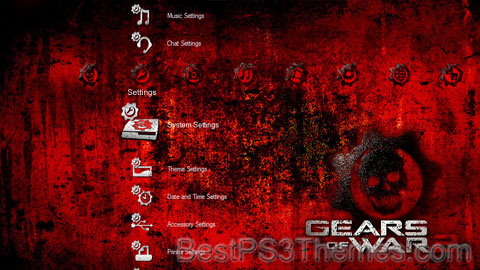
(1 background)
Gears of War 2 is a third-person shooter video game developed by Epic Games and published by Microsoft Game Studios for the Xbox 360. It is the second installment of the Gears of War series, with lead design by Cliff Bleszinski. The game was released in North America, Europe and Australia on November 7, 2008, and was released in Japan on July 30, 2009. The game expands technically on the previous game by using a modified Unreal Engine 3. The development team brought in comic book writer Joshua Ortega to help write the plot for the game.
In Gears of War 2, the COG continues its fight against the Locust, who are attempting to sink all of the cities on the planet Sera. Sergeant Marcus Fenix leads Delta Squad into the depths of the planet to try to stop the Locust during the assault upon Locust territory. The player controls Fenix in the main mission campaign, with the ability to play cooperatively with a second player controlling Fenix's best friend and fellow Squad member Dominic "Dom" Santiago. The game includes several existing and new multiplayer modes including five-on-five battles between human and Locust forces, and a "Horde" mode that challenges up to five players against waves of Locust forces with ever-increasing strength. New weapons and gameplay mechanics such as "chainsaw duels" and the ability to use downed foes as "meatshields" were added to the game.
On its release weekend, Gears of War 2 sold over two million copies, and within two months of release, had sold four million copies. It was the seventh best selling video game of 2009 and received several accolades. The game received similar praise as its predecessor, with the new gameplay and multiplayer modes seen as outstanding additions. Gears of War 2, along with its predecessor, is considered one of the best games ever made. It was followed by Gears of War 3 in 2011.
Gameplay[edit]
Gears of War 2 is a third-person shooter with an emphasis on the tactical use of cover, and retains much of the same gameplay from the first game. The player, playing as either Marcus or Dominic in the campaign mode, or as any of the human or Locust characters in multiplayer mode, can only carry a pistol, one type of grenade, and two other weapons at any time, though they may swap these for weapons found in strategic locations or left by downed foes or fallen allies. Each weapon can be used for normal fire as well as for melee attacks; the game's signature Lancer Assault Rifle can be used to instantly kill foes in melee with its mounted chainsaw bayonet. The game introduces the ability to engage in chainsaw duels should the player attempt to chainsaw an opponent also using the Lancer; the player is presented with a controller button to press rapidly to try to win the duel and avoid death.[1] Gears of War 2 rebalances the power of the existing weapons while introducing five new ones: a flamethrower, a chain gun, a mortar cannon, a "Gorgon" Pistol, and the Ink Grenade. The chain gun and the mortar are heavy weapons, forcing the player to move at walking speed while carrying it in both hands. The Gorgon Pistol is an SMG-like machine pistol that fires four four-shot bursts per magazine. The Ink Grenade doesn't damage with its detonation, but instead temporarily poisons the area it was thrown, making it very useful for driving enemies out of cover. Grenades can be planted on walls or floors as proximity traps that go off when an enemy nears, but only fragmentation grenades have the ability to kill foes when they go off.[2]
The player's health is represented by a red "Crimson Omen" that fades onto the screen the more damage the player takes; staying out of the line of fire allows the player to recover their health. Depending on the game mode or difficulty, if the player takes too much damage, they enter a downed state where they can crawl around the map to get out of battle and seek help. During this time, a teammate can revive him, an enemy may brutally execute the downed player, or the player may bleed out if too much time has passed. The player can also grab a downed character and use them as a meatshield, allowing the body to absorb damage but forcing the player to use a one-handed pistol.[3] Explosive weapons will simply destroy the character they strike.[4] Like its predecessor, Gears of War 2 features an optional mature content filter, which, when active, makes blood appear as sparks and removes harsh language from the dialogue.[5] Furthermore, progress towards most of the Xbox achievements for the game can be earned in either campaign or multiplayer modes.[1]
Campaign mode[edit]
The campaign mode in Gears of War 2 allows for a single player or two players playing cooperatively as Marcus or Dom. A new "Normal" difficulty was added between the game's "Casual" and "Hardcore" difficulties. There is also an 'Insane' difficulty that is unlocked after the player completes the game at least once. Players in co-op mode can select different difficulties, and a "communal combat system" will adjust the game's artificial intelligence to give both players a fair challenge.[1] The co-op campaign can be played in a drop in/drop out manner, with the second player able to join the first player's game in progress.[6] As well as collecting some COG tags as in the first game, players can search other story-based items such as personal letters and medical records, with discovered items being added to a war journal.[1]
The campaign features a deeper story with new characters, new weapons, and new enemies according to John DiMaggio, the voice actor for Marcus Fenix.[7] New vehicles have been added to the game, such as the Centaur Tank, which lead designer Cliff Bleszinski describes as a "tank with monster truck wheels."[8] Players will also ride a Brumak and Reavers in the game.[9] Cut-scenes use the better facial rendering technology of Epic's Unreal engine, and engage in more dramatic angles for the conversation, as well as using a video screen on Jack (the all-purpose robot used by Delta squad) to talk with their commanders face-to-face.[1]
Multiplayer[edit]
Gears of War 2 features an upgraded multiplayer mode that allows up to ten users to simultaneously play in teams of five-on-five.[10] Gears of War 2 includes most of the multiplayer modes, including Execution, Warzone, Annex and King of the Hill, and adds in three new modes.[2][10] Guardian is a modified version of Assassination from the original Gears of War, but allows players to continue fighting after the leader has been killed, but losing the ability to respawn.[10] Wingman splits all ten players into five teams of two, where both members of a team play as the same character.[10] Submission, formerly known as Meat Flag,[2] is a version of capture the flag in which players attempt to "down" an enemy controlled by the game's AI and move its body to their team's base or objective to earn points. The 10 maps shipped with the game originally are Avalanche, Blood Drive, Day One, Hail, Jacinto, Pavilion, River, Ruins, Security and Stasis.[10] A Halo-like matchmaking system has been utilized for the online multiplayer.[1] Players can now engage in multiplayer scenarios with any combination of human players and artificial intelligence controlled by the game, with the ability to set the AI's intelligence level.[11] Horde is a new co-op mode for five players, fighting off waves of attacking Locust together, with each wave becoming more difficult.[9] Horde Mode does not feature bot support as in competitive multiplayer, and can be played alone.[12]
Players can pan around a map as the camera focuses on areas of intense fighting, and the Ghost Cam allows a player to roam freely around a map. The ability to take photographs is also featured, which enables the player to take a photo, which can be uploaded to the Gears of War website and is rated on the quality of action in the shot.[2]
Synopsis[edit]
Setting[edit]
Gears of War 2 takes place six months after the detonation of the Lightmass Bomb at the end of the first game. Though most of the underground army of the Locust Horde was destroyed, the explosion also caused much of the liquid Imulsion underground to vaporize, causing a fatal disease called Rustlung to spread among the diminished human population. After months of peace, the cities of Tollen and Montevado suddenly and mysteriously disappear underground, leading the Coalition of Ordered Governments (COG) to suspect the resurgence of the Locust.[13] Soon after, the once impenetrable Jacinto, one of the last remaining safe havens for humans, begins to show signs that the same fate awaits it. To stop the fall of Jacinto, the COG responds with a large-scale counter-offensive against the Locust.[1][13] Senior Producer Rod Fergusson says "In order to save Jacinto, [the COG] have no choice but to take the war to the Locust."[1]
Characters[edit]
Returning characters includes the main protagonists of the series Marcus Fenix and Dominic Santiago and others from the first game, including Marcus and Dom's fellow Delta Squad COG soldiers, Augustus 'Cole Train' Cole and Damon Baird. Also returning in supporting roles are radio dispatcher Anya Stroud and senior officer Colonel Hoffman. Lead designer Cliff Bleszinski confirmed that the character Carmine would be returning, but did not reveal how or in what capacity as Carmine was killed in the original Gears of War.[14] It was later revealed that the original Anthony Carmine would not be present in the Gears of War 2 campaign, but rather his brother, Benjamin,[15] would make an appearance.[16] The game also introduces several new characters. They include Chairman Prescott, the noble, yet near-dictatorial military leader of COG; Tai Kaliso, "a spiritual and meditative warrior from a tradition of honor bound fighters;" and Dizzy Wallin, a former Stranded who joined the COG to keep his family safe. Dom's wife Maria also makes an appearance, and Dom's search for her plays an important part in the story.[1]
Plot[edit]
As Gears of War 2 begins, the COG army mobilizes forces to deploy into the depths of Sera, known as the "Hollow", to assault the Locust directly. Delta Squad, consisting of Marcus Fenix, Dom Santiago, Benjamin Carmine, Tai Kaliso, Augustus Cole and Damon Baird; fight the Locust alongside thousands of Gears. During the battle, Tai is taken prisoner by Locust general Skorge and is tortured to the point of insanity, resulting in him committing suicide after being freed by Delta. They discover that the Locust are using a giant Riftworm to sink the human cities. The Locust plan to destroy the rock structures in the outskirts of Jacinto, the last major human city, in hopes of sinking it underground. Delta kills the Riftworm from within before it can sink Jacinto, but they lose Carmine in the process.
After returning to the surface, Colonel Hoffman admits the COG failed in locating the Locust stronghold. Chairman Prescott declassifies an intel file that reveals a nearby abandoned COG outpost that has a lead on the location of the Locust capital and their queen. Delta is ordered to investigate. Inside, Delta learns that the outpost is "New Hope", a genetics lab dedicated to studying human children of Imulsion miners suffering from Rustlung, resulting in mutated experiments called "Sires". Delta finds that the scientists relocated to the nearby caverns of Mount Kadar to continue their research. As Delta infiltrates Mount Kadar to infiltrate the Locust stronghold, Dom gets a lead on his missing wife, Maria, located at a nearby prison camp. Dom finds Maria in a vegetative state due to the aggressive and invasive torture techniques of the Locust. Dom euthanizes Maria and continues on the mission.
Delta locates Locust capital, Nexus, and sets off the beacon to initiate the second wave. The COG sees the Locust have been facing an epidemic against the "Lambent", Locust who have been exposed to Imulsion, and have been forcing the Locust out of the Hollow and onto the surface. Locust Queen Myrrah, who appears human, reveals to Marcus that the Locust are trying to sink Jacinto based on a proposal by Adam Fenix, his father, that the surrounding seawater could flood the Hollow and drown the Lambent. After a battle where they succeed in killing Skorge, but failing to kill Myrrah, Marcus decides to destroy both the Locust and Lambent forces by sinking Jacinto themselves before the Locust can evacuate. Jacinto is sunk by the COG and seawater floods into the crater, destroying the remaining Locust forces. After the credits, the voice of Adam Fenix is heard on a radio transmission, revealing he is still alive.[4][17]
Development[edit]
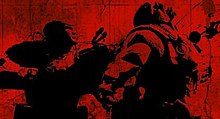
Gears of War designer Cliff Bleszinski has done several interviews to highlight improvements to the game. Heavy Netcode optimization has been done to negate the host advantage problem in the first title[18] and hundreds of tweaks have gone into improving the cover system and movement.[19] To provide a deeper story, the team brought aboard novelist Joshua Ortega as to incorporate more personal drama within the sci-fi setting.[1] Steve Jablonsky provided the music for the game.[20] Epic Games also considered making the game easier after complaints about Gears of War. Senior producer Rod Fergusson admitted that — for the first game — "We overshot on [the Casual] difficulty and a game that was a little harder than we intended."[1]
A teaser image posted to the Gears of War 2 website on July 8, 2008, suggested that the game was to be released on November 9, 2008, but it was confirmed during the Microsoft E3 2008 press conference that the game would be released on November 7, 2008.[9][21] On July 14, 2008, the teaser image was removed and the website relaunched and updated for Gears of War 2.[22]
Gears of War 2 was a focal point during Microsoft's E3 2008 presentation on July 15, 2008, which included a "hands-on" demo.[23][24] A second trailer, entitled "Rendezvous," was made available on July 14, 2008, as a part of E3. The Joseph Kosinski-directed trailer,[25] which features the Trans Am track "Diabolical Cracker" from the album Red Line, takes its title and spoken words from Alan Seeger's World War I poem I Have a Rendezvous with Death.[26] The game's release date was also set, with a worldwide release to occur on November 7, 2008.[9] Microsoft and Epic Games announced on October 10, 2008, that Gears of War 2 had gone gold.[27] It was stated by Cliff Bleszinski that, unlike Gears of War, the previous installment, Gears of War 2 will not feature a PC port.[28]
Graphics[edit]

At the 2008 Game Developers Conference in San Francisco, California, as a showcase for the functionality of the Unreal Engine 3, Gears of War creators Epic Games showed various improvements to the engine with specific reference to the sequel itself. The video showed several demonstrations of the improvements, the initial being improvements to the in-game lighting through Screen Space Ambient Occlusion, in which dynamic shadows could be generated through the use of a pixel shading technique to render more realistically lit and shaded objects and actors, illustrated through comparison between character and environment models in the original game engine to that of Unreal Engine 3. Also showcased was the ability of the engine to render hordes of actors within the engine, as demonstrated with a large crowd of locust flocking through the "Gridlock" multiplayer map from the original game. Alongside this technology was improvements to "Matinee," an artistic tool used for the rendering and editing 3-dimensional scenes within the game.[29]
Other physics-related features included improvements to the rendering of water in which specular light and physical interactions with were displayed more realistically, improvements to soft body entities demonstrated with a "Meat Cube" and a floating ball possessing properties similar to that of liquid helium. The largest of these physics engine related changes was the introduction of destructible environments due to the implementation of real-time structural analysis tools to generate the damage of the materials and subsequently their deformed shapes based upon resultant forces placed upon them. This was demonstrated with the use of explosive arrows fired from the "Torque Bow" of the original game causing damage to wooden planks, and also revealing rebar present after destroying areas of a stone structure.[29]
Downloadable content and updates[edit]
On February 20, 2008, coinciding with the game's announcement at the Game Developers Conference, a free set of gamer pictures and a dashboard theme, as well as a teaser trailer titled "Duel," were made available via the Xbox Live Marketplace.[30] The first footage of gameplay from the campaign, highlighting new features of the game, was released online and to the Marketplace on May 9, 2008.[31] After the Microsoft E3 press conference, the "Rendezvous" trailer and the press conference demonstration was available for download as well as a new free set of gamer pictures and a dashboard theme.[26] Upon release, every new copy of Gears of War 2 features a code to download the "Flashback Map Pack," which includes five enhanced multiplayer maps from the original game. Customers who attended the GameStop Midnight Madness game release event received a code to unlock a gold-plated Hammerburst rifle for use in multiplayer and a code for an exclusive Xbox 360 Dashboard theme optimized for the New Xbox Experience.[32]
The first downloadable content released after Gears of War 2 was the "Combustible Map Pack," which consists of three new multiplayer maps. This add-on was announced and released on December 15, 2008.[33] The second title update was released on January 21, 2009, featuring several adjustments to gameplay and adding additional Achievements, the patch attempts to correct many of the "glitches" that players have discovered since the game's release.[34][35]
A third update was applied to Gears of War 2 on March 24, 2009. The update added an experience-based ranking system in which the player is given a numerical value based on their number of experience points, which are gained by shooting or killing enemies in public multiplayer. The update also addressed several issues with matchmaking, including adding bots in place of players who have quit or lost connection to the game.[36]
In early July 2009, Epic Games applied a fourth update to Gears of War 2, which added the ability to gain experience from the multiplayer Horde Mode, as well as applying several more gameplay fixes.[37][38] On July 28, 2009, the "Dark Corners" add-on was released. This add-on consisted of seven new multiplayer maps, and an additional campaign chapter that was originally deleted from the game.[39] The deleted scene takes place after Maria's death, where the user can choose to either sneak into the stronghold as Theron Guards or charge in as in the original game, though the level is different from the one that appeared in the final game and features a cameo from a Stranded character from the original Gears.
All Fronts Collection[edit]
On May 6, 2009, Microsoft and Epic Games issued a joint press release announcing the Gears of War 2: All Fronts Collection, to be released on July 28, 2009. The All Fronts Collection was to be sold as a retail package, and would have included all add-ons released for Gears of War 2, a poster, and a strategy guide for the game.[40] In response to complaints that the All Fronts Collection had identical pricing to the Dark Corners add-on, but significantly more content, as well as the All Fronts Collection retail package not being made available in certain regions, Epic Games adjusted the release plan; the All Fronts Collection was released digitally via Xbox Live and the Dark Corners add-on was reduced in price.[41]
Stereoscopic 3D[edit]
In June 2010 during the Electronic Entertainment Expo 2010 Mark Rein (vice president of Epic Games) was showcasing a tech demo of Gears of War 2 in stereoscopic 3D running on an Xbox 360 thanks to the TriOviz for Games Technology. "This technology's great because it works on normal HD TVs, as well as the very high end 3DTVs," Rein commented to Computer and Video Games. "We're not planning to re-release this in 3D - unless Microsoft want us to - but I'm sure its technology may be keen to put in the games developed by our partners."[42]
In October 2010 TriOviz for Games Technology has been integrated in Unreal Engine 3, allowing to easily convert in stereoscopic 3D, numerous past and upcoming games developed with this engine.[43][44]
Marketing[edit]
A Limited Edition of the game was confirmed on February 20, 2008.[45] On July 14, 2008, more information about the Limited Edition's contents was revealed. The edition features alternative cover art, a SteelBook case with a bonus content DVD, a book entitled Beneath the Surface: An Inside Look at Gears of War 2, which includes concept art and story-related information, a keepsake photo of Dominic and Maria, and an exclusive Xbox Live code to unlock a gold-plated Lancer for online play.[46][47] As a bonus item promoted by electronics store Best Buy, customers who preordered the Limited Edition also received a bonus Remote Control Centaur Tank replica, just like the new vehicle introduced in the game, free of charge.[48]
Reception[edit]
Critical reception[edit]
| Aggregator | Score |
|---|---|
| GameRankings | 93.32%[49] |
| Metacritic | 93/100[50] |






